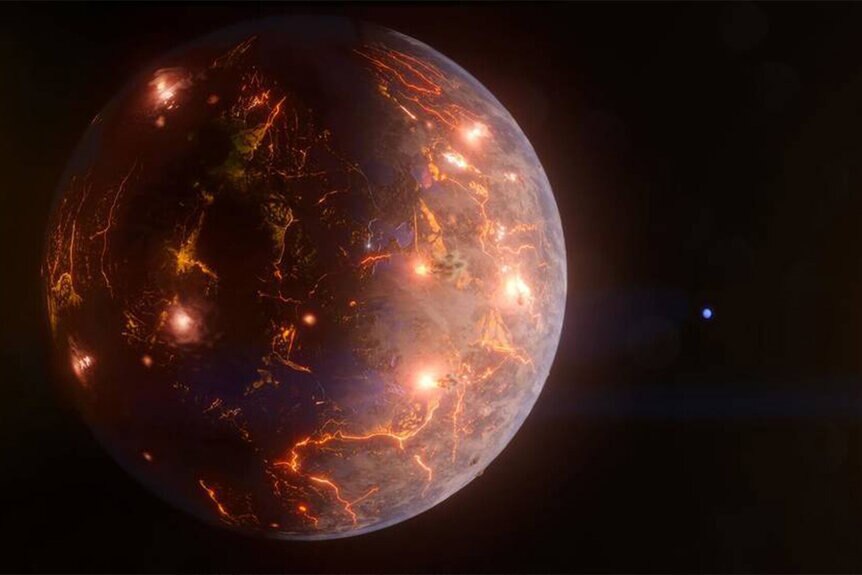Create a free profile to get unlimited access to exclusive videos, sweepstakes, and more!
Exoplanet Lp 791-18 D Is a Volcanic Hellworld
We've got it pretty good here.

In the SYFY original series The Ark (streaming now on Peacock!), a crew of human explorers embarks upon a one-way journey to Proxima centauri b. It’s an Earth-sized planet inside the habitable zone of Proxima Centauri, the nearest star to Earth, next to the Sun of course. The relatively short travel time makes it a good target for human exploration, but it probably wouldn’t be the comfiest place to set down roots.
Proxima centauri is a red dwarf and its habitable zone is close in. Living on Proxima b might be closer in experience to living on a world like Mercury, but larger. The planet is probably tidally locked, splitting the world into two constant hemispheres of perpetual day and night. It also orbits its star every week and a half, potentially causing chaotic weather systems. Proxima b isn’t the most hospitable place in the universe, but it’s practically a paradise compared to LP 791-18 d, which heard the term “Hell on Earth” and took it to heart.
RELATED: SYFY's The Ark Creators, Stars Dig Into Season 1 Finale Cliffhanger & Tease Season 2 Plans
LP 791-18 d is a recent addition to our growing list of alien worlds and the third world found around its parent star LP 791-18. Astronomers identified and studied the planet using two different space-based telescopes: NASA’s Transiting Exoplanet Survey Satellite (TESS) and the now-retired Spitzer Space Telescope. The results of their observations were published in the journal Nature.
HOW TO BUILD A HELLWORLD IN SPACE
The LP 791-18 system is about 90 light-years away, in the southern constellation Crater, and it’s a model system for how to create a hellscape. It starts with a relatively small red dwarf, the most common type of star in the Milky Way. Its innermost planet, LP 791-18 b, is a little larger than Earth and keeps a tight orbit around the star. The second planet, LP 791-18 c, is a super-Earth, roughly 2.5 times Earth’s diameter and more than seven times as massive. It plays an important role in pushing LP 791-18 d, the system’s fourth planet, onto the list of worst places in the universe to visit.
That’s because LP 791-18 d has the misfortune of orbiting very near its more massive sibling. Every time they get near, the gravitational tug from LP c distorts LP d’s orbit a little bit, resulting in an elliptical orbit. And that’s where the real magic begins. The fourth planet’s uneven orbit brings it intermittently nearer and farther from its star. The constantly changing push and pull from the star and from LP c, creates friction in the planet’s interior. That creates heat, the same way your hands warm up when you rub them together, and all of that heat has to go somewhere.
LP 791-18 d sits at the inner edge of the system’s habitable zone, where it’s possible for liquid water to exist. Unfortunately, the planet is tidally locked, leaving one side bone dry, baked by the endless light of everlasting day. That’s usually a surefire way to lose your water, but the planet’s immense volcanic activity could sustain an atmosphere. If that’s the case, temperatures on the night side could get cool enough for water to condense on the surface.
Any life there, whether endemic (alien) or invasive (human) would have a rough go of it. Astronomers expect that LP 791-18 d is as volcanically active as Jupiter’s moon Io (eye-oh), the most volcanically active world in our solar system. Io has hundreds of active volcanoes spewing lava at any given moment, and its surface is blanketed with lava flows stretching hundreds of kilometers from their source.
Contrary to our intuition, the volcanoes of LP 791-18 d, might be the only thing giving any life there a fighting chance. It’s larger sibling, LP c, is scheduled for future observation by NASA’s JWST, and it’s only a quick jump to set sights on LP d. We’re grateful for the remote viewing capabilities of our space-based instruments, because LP 791-18 d is the kind of place best seen from a distance.
The Ark isn’t going to Hell, but they are going through it. Catch the action, streaming now on Peacock!





























